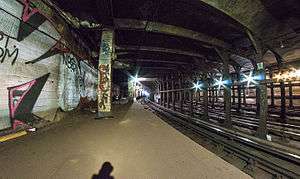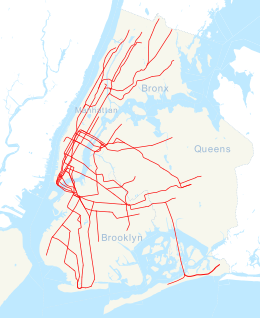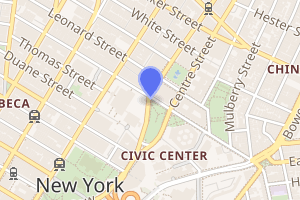Worth Street station
Worth Street was a local station on the IRT Lexington Avenue Line of the New York City Subway. It is located at Lafayette Street and Worth Street, in Civic Center, Manhattan. The station opened on October 27, 1904 and was closed on September 1, 1962 due to its proximity to the Brooklyn Bridge–City Hall station.
Worth Street | |||
|---|---|---|---|
| Former New York City Subway station | |||
 Platform of the Worth Street station | |||
| Station statistics | |||
| Address | Lafayette Street & Worth Street New York, NY | ||
| Borough | Manhattan | ||
| Locale | Civic Center | ||
| Coordinates | 40.7155°N 74.003°W | ||
| Division | A (IRT) | ||
| Line | IRT Lexington Avenue Line | ||
| Services | None (abandoned) | ||
| Structure | Underground | ||
| Platforms | 2 side platforms | ||
| Tracks | 4 | ||
| Other information | |||
| Opened | October 27, 1904[1] | ||
| Closed | September 1, 1962[2] | ||
| Station succession | |||
| Next north | Canal Street | ||
| Next south | Brooklyn Bridge–City Hall | ||
| |||
| |||
History
Opening
Operation of the first subway began on October 27, 1904, with the opening of the original 28 stations of the New York City Subway from City Hall to 145th Street on the West Side Branch, including the Worth Street station.[3][4]
The first collision in the history of the New York City Subway system occurred at the station on January 11, 1905. On that date, the motorman of a southbound Lenox Avenue train did not obey a caution signal at the Spring Street station, which indicated that there was a train ahead between Canal Street and Worth Street, and collided into a Broadway train that was stopped at Worth Street, waiting for a signal to clear.[5] The accident shattered the glass in the rear car of the Broadway train, and the first two cars of the Lenox Avenue train. Six people were hurt by falling glass.[6] The accident could have been averted if the local tracks had automatic tripping devices, which were present on the express tracks.[7] The installation of these devices on the local tracks was considered to be impractical due to the high frequency of local service.[5] The accident only resulted in a ten minute delay in service, and after it was determined no people were killed, the trains proceeded in regular service.[8]
On March 20, 1906, the Interborough Rapid Transit Company tested a vacuum cleaner connected to a portable wagon plant to clean the station. It found that it was very successful at removing dust from the station's tiling and woodwork, and at removing greasy dirt from girders.[9][10]
Renovation
The station was lengthened twice. Like all the local stops, it was originally about 200 feet (61 m) long to accommodate five-car trains. The first door of the first car and last door of the last car were left past the platform ends and were not opened. Because of overcrowding, the Public Service Commission ordered the local platforms extended a few yards into the "manholes" at the ends, that is, the space left for access to equipment closets. Completed in 1910, this gave just enough room for six-car local trains with only a door of the first and last cars at the platform. The downtown platform was lengthened in 1948 by the New York City Board of Transportation, providing for the full length of a ten-car, 514-foot-long (157 m) train.[11] The work was done only on the downtown side to save costs, and that platform was chosen for lengthening since it was the main unloading side in the business district.
Closure
.jpg)
On January 3, 1957, the New York City Transit Authority announced that this station would be closed within two years as part of a plan to improve the Brooklyn Bridge–City Hall station. As part of the project, the platforms at Brooklyn Bridge would be lengthened to accommodate ten-car trains, and the curved platform at Brooklyn Bridge would be eliminated. In order to achieve both of these goals, the platforms would be extended 250 feet (76 m) to the north. The Worth Street station would be closed as it would only be 600 feet (180 m) feet away from the platforms at Brooklyn Bridge. If the station were retained, service on the line would be slowed down, and there was no suitable signal system that could operate with such a short distance. The project would cost $4.4 million and was projected to take two years.[12]
The station was closed on September 1, 1962 with the completion of work at Brooklyn Bridge. While the opening of new entrance at the northwest corner of Reade Street and Lafayette Avenue on that date,[2] it ended up opening a week later.[13] After the Worth Street station's closure, Brooklyn Bridge–City Hall was renamed Brooklyn Bridge–Worth Street.[14] The name change was reverted in 1995.
Station layout
| G | Street level | |
| P Platform level |
Side platform, not in service | |
| Northbound local | ← | |
| Northbound express | ← | |
| Southbound express | | |
| Southbound local | | |
| Side platform, not in service | ||
This underground station has four tracks and two side platforms, which are curved.[15] The curves made it impossible for all doors on trains to open at the station, when it was in use,[16] and many accidents occurred at the large gaps between trains and the platforms.[17] The station platforms are lined with white tiled rectangular columns, with alternate tiles having tiles reading "WORTH".[18] The station walls were tiled with white glass tile and glazed terra cotta cornices. The main color for the name tablets and cornices was dull green.[19] The platforms also had shields with the white letter "W".[20] Alternating columns between the local and express tracks had black on white signs reading "Worth."[21] The station's walls and columns have been heavily covered with graffiti.[22] Wide fare control area were located at the southern end of the platforms.[23]
It lies beneath the sidewalk on the west side of Foley Square. When the Federal Plaza Building was in the planning stages, it was found that, because of the existence of the station, the building could not extend out to Foley Square. As a result, that structure is set far back from the street, well beyond the station. The building's plaza and fountain lie directly above the station. The station's platforms are visible from the side windows of trains between Canal Street and Brooklyn Bridge–City Hall.
See also
- 18th Street (IRT Lexington Avenue Line)
- 91st Street (IRT Broadway – Seventh Avenue Line)
References
- "Our Subway Open: 150,000 Try It; Mayor McClellan Runs the First Official Train". The New York Times. October 28, 1904. p. 1. ISSN 0362-4331. Retrieved April 21, 2020.
- Grutzner, Charles (September 1, 1962). "New Platform for IRT Locals At Brooklyn Bridge to End Jams". The New York Times. p. 42. ISSN 0362-4331. Retrieved May 30, 2010.
- James Blaine Walker, Fifty Years of Rapid Transit, 1864-1917, published 1918, pp. 162-191
- "New York City subway opens - Oct 27, 1904". history.com. October 27, 1904. Retrieved October 25, 2015.
- "Blames Motorman For Crash In The Subway. Superintendent Hedley Declares He Ran Past Signals—Clever Device to Guard Express Trains". New York Evening World. January 11, 1905. Retrieved July 6, 2020.
- "Accident In The Subway". Fort Wayne Daily News. January 11, 1905. Retrieved July 6, 2020.
- "First Collision On The New Subway. Fault of Motorman Who Disregarded Warning Signal". Albuquerque Journal. January 18, 1905. Retrieved July 6, 2020.
- "Brooklynites In Crash. Subway Train, Carrying Party Home from Euchre, in Collision—Three Badly Hurt". Brooklyn Times Union. January 11, 1905. Retrieved July 6, 2020.
- "Clean Subway By Vacuum. Plain Is Tried as an Experiment and Is Declared To Have Been Successful". The New York Herald. March 21, 1906. Retrieved July 6, 2020.
- "Vaccum Cleaning Tried In Subway. Interborough Makes Practical Test of System at Worth Street Station". Compressed Air. 11 (3): 4049. May 1906.
- Proceedings of the New York City Board of Transportation. New York City Board of Transportation. 1949. p. 1585.
- Levey, Stanley. "IRT Will Abandon Worth St. Station; Decision Based on Planned Extension of the Brooklyn Bridge Stop by 250 Feet". The New York Times. ISSN 0362-4331. Retrieved September 4, 2016.
- ERA Headlights. Electric Railroaders Association. 1962.
- "IRT Worth St. Station To Be Closed Reade-Lafayette Stairway To Open". Flickr. New York City Transit Authority. 1962. Retrieved July 6, 2020.
- Dougherty, Peter (2020). Tracks of the New York City Subway 2020 (16th ed.). Dougherty. OCLC 1056711733.
- "Station To Open: $6-Million Subway Platform In Lower Manhattan". The Hackensack Record. August 29, 1962. Retrieved July 6, 2020.
- Skinner, Burrhus Frederic (1957). Verbal Behavior. Appleton-Century-Crofts.
- "Image of the southbound platform at Worth Street". nycsubway.org. 1960. Retrieved July 6, 2020.
- "The Subway and its Stations". Harper's Weekly. 47 (2406): 176. January 31, 1903.
- "Shield at Worth Street". Abandoned Stations. 2002. Retrieved July 6, 2020.
- "Worth Street sign on column". Abandoned Stations. Retrieved July 6, 2020.
- Anastasio, Joe (August 17, 2005). "Exploring the Abandoned Worth Street Subway Station (2005)". ltvsquad.com. Retrieved July 6, 2020.
- "Fare Control Area at Worth Street". guerrillaexploring.com. Retrieved July 6, 2020.
External links
| Wikimedia Commons has media related to Worth Street (IRT Lexington Avenue Line). |
- nycsubway.org – IRT East Side Line: Worth Street
- Abandoned Stations — Worth Street
- Forgotten NY — Original 28 - NYC's First 28 Subway Stations




